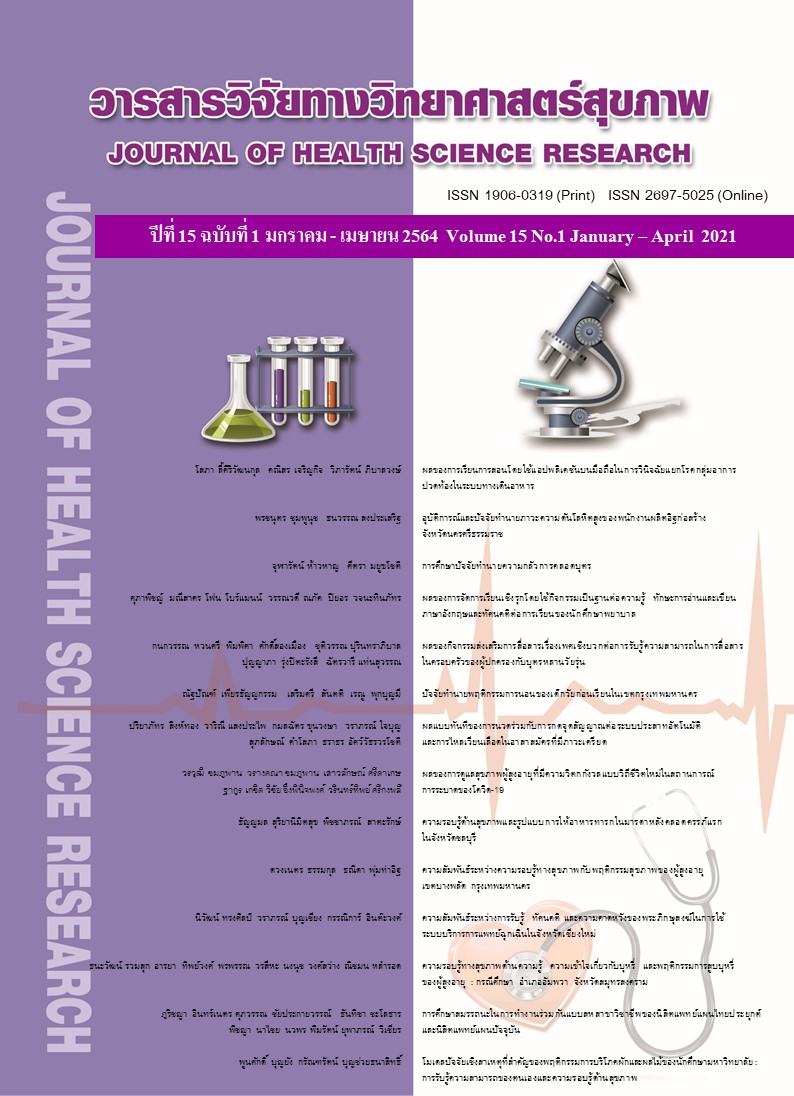อุบัติการณ์และปัจจัยทำนายภาวะความดันโลหิตสูงของพนักงานผลิตอิฐก่อสร้าง จังหวัดนครศรีธรรมราช
Main Article Content
บทคัดย่อ
บทนำ : ลักษณะงานของอุตสาหกรรมผลิตอิฐก่อสร้างเป็นงานที่มีความเสี่ยงต่อการเกิดปัญหาสุขภาพโดยเฉพาะภาวะความดันโลหิตสูง จากการใช้แรงงานคนเป็นหลัก มีหลายกระบวนการผลิตพนักงานต้องทำงานสัมผัสปัจจัยคุกคามทางสุขภาพ โดยขาดความรู้ถึงผลกระทบและการป้องกันตนเอง
วัตถุประสงค์การวิจัย : เพื่อศึกษาอุบัติการณ์ และปัจจัยทำนายภาวะความดันโลหิตสูงของพนักงานผลิตอิฐก่อสร้าง จังหวัดนครศรีธรรมราช
วิธีการวิจัย : การวิจัยเชิงพรรณนา ตัวอย่าง คือ พนักงานผลิตอิฐก่อสร้าง จังหวัดนครศรีธรรมราช จำนวน 163 ราย เครื่องมือการวิจัย ได้แก่ 1) แบบสอบถามข้อมูลส่วนบุคคล 2) แบบประเมินการสัมผัสปัจจัยคุกคามสุขภาพจากการทำงาน 3) แบบประเมินความเครียด และ 4) การตรวจร่างกาย ได้แก่ ดัชนีมวลกาย เส้นรอบเอว และระดับความดันโลหิต วิเคราะห์ข้อมูลโดยใช้สถิติพรรณนา สัมประสิทธิ์สหสัมพันธ์ของเพียร์สัน และการวิเคราะห์ถดถอยเชิงเส้นพหุคูณ
ผลการศึกษา : พบว่า ร้อยละ 48.50 ของตัวอย่างมีภาวะความดันโลหิตสูง ปัจจัยส่วนบุคคล ได้แก่ เพศ เส้นรอบเอว การสูบบุหรี่ ประวัติการเจ็บป่วย ระดับการศึกษา สิทธิการรักษา และปัจจัยการทำงาน ได้แก่ สิ่งคุกคามสุขภาพด้านกายภาพ ด้านชีวภาพ และด้านการยศาสตร์ มีความสัมพันธ์ต่อภาวะความดันโลหิตสูง (p<.05) โดยตัวแปรด้านเพศ ปัจจัยคุกคามสุขภาพด้านกายภาพ และเส้นรอบเอว สามารถร่วมกันทำนายภาวะความดันโลหิตสูงของตัวอย่างได้ถึงร้อยละ 23.30 อย่างมีนัยสำคัญทางสถิติที่ระดับ .01 (R2= 0.233, F = 17.464, p<.001)
สรุปผล : พยาบาลควรจัดกิจกรรมส่งเสริมสุขภาพที่เน้นการปรับเปลี่ยนพฤติกรรม และปรับปรุงสภาพแวดล้อมในการทำงาน
Downloads
Article Details
บทความที่ได้รับการตีพิมพ์เป็นลิขสิทธิ์ของวิทยาลัยพยาบาลบรมราชชนนี จังหวัดนนทบุรี
ข้อความที่ปรากฏในบทความแต่ละเรื่องในวารสารวิชาการเล่มนี้เป็นความคิดเห็นส่วนตัวของผู้เขียนแต่ละท่านไม่เกี่ยวข้องกับวิทยาลัยพยาบาลบรมราชชนนี จังหวัดนนทบุรี และคณาจารย์ท่านอื่น ในวิทยาลัยฯ แต่อย่างใด ความรับผิดชอบองค์ประกอบทั้งหมดของบทความแต่ละเรื่องเป็นของผู้เขียนแต่ละท่าน หากมีความผิดพลาดใด ๆ ผู้เขียนแต่ละท่านจะรับผิดชอบบทความของตนเองแต่ผู้เดียว
เอกสารอ้างอิง
World Health Organization (WHO). A global brief on hypertension Silent killer, global public health crisis [Internet]. 2013 [Cited 2020 Apr 1]; Available from http://www.who. int/cardiovasculardiseases/publications/glo bal brief hypertension/en/.
Strategy and Planning, Ministry of Public Health. Public health statistics. [internet]. 2015. [Cited 2020 Mar 10]; Available from http://bps.moph.go.th/new_bps/sites/default /files/health_Statis2558.pdf. (in Thai).
Kawakami T, Khai TT, Kogi K. Research that can support self-help initiative of local farmers to improve safety & health at work: birth & growth of WIND training program in Viet Nam. J Saf Health Envi Res. 2012;8(1):11-8.
Morioka I, Miyai N, Miyashita K. Hot environment and health problems of outdoor workers at a construction site. Ind Health. 2006;44(3):474-80. doi: 10.2486/indhealth.44.474.
Penney PJ, Earl CE. Occupational noise and effects on blood pressure: exploring the relationship of hypertension and noise exposure in workers. AAOHN J. 2004;52 (11):476-80. doi: 10.1177/2165079904052 01107.
Landsbergis P. Long work hours, hypertension, and cardiovascular disease. Cad Saude Publica. 2004;20(6):1746–8. doi.10. 1590/S 0102-311X20040 00600035.
Department of Industrial Works. Industrial information for staff. [internet]. 2019 [cited 2020 Apr 10]; Available from http://reg. diw.go.th/executive/amp2.asp?amp=1&prov=80. (in Thai).
Krejcie R, Morgan DW. Determining sample size for research activities. Educ psychol meas. 1970;30(3):607-10. doi:10.1177/00131644 7003000308.
Chanprasit C, Kaewthummanukul T, Songkham W, Chareonsup Y. Health hazards identification, health status, work-related injury and illness situational analysis in Wooden furniture enterprises. Nursing Journal. 2010;37(1):1-14. (in Thai).
Department of Mental Health, Ministry of Public Health. Suanprung Stress Test-20. [internet]. 2016 [Cited 2020 Apr 15]; Available from http://www.dmh.go.th/test/ stress/. (in Thai).
National High Blood Pressure Education Program. The Seventh Report of the Joint National Committee on Prevention, Detection, Evaluation, and Treatment of High Blood Pressure. Bethesda (MD): National Heart, Lung, and Blood Institute (US); 2004 Aug. Report No.:04-5230.
Das B. Prevalence of work-related musculoskeletal disorders among brick field workers of West Bengal, India. Arch Environ Occup Health. 2014;69(4):231-40. doi: 10.1080/19338244.2013.771249.
Karoonngamphan M, Suvaree S, Numfone N. Health behaviors and health status of workers: A case study of workplaces in Sathorn district, Bangkok metropolitan. Songklanagarin Journal of Nursing. 2012; 32(3):51-66. (in Thai).
Singh DP. Woman workers in the brick kiln industry in Haryana, India. Indian J Gend Stud. 2005;12(1):83-97. doi: 10.117 7/097152 150401200104.
Guyton AC. Textbook of medical physiology. 12th ed. Bangalore: Prism Books; 2011.
Chandola T, Brunner E, Marmot M. Chronic stress at work and the metabolic syndrome: prospective study. Br Med J. 2006;332(7540):521-5. doi: 10.1136/bmj. 38693.435301.80.
Kibria GMA, Swasey K, Hasan MZ, et al. Determinants of hypertension among adults in Bangladesh as per the Joint National Committee 7 and 2017 American College of Cardiology/American Hypertension Association hypertension guidelines. J Am Soc Hypertens. 2018;12(11):45-55. doi: 10.10.16/j.jash.2018. 10.004.
Nkeh-Chungag BN, Mxhosa TH, Mgoduka PN. Association of waist and hip circumferences with the presence of hypertension and pre-hypertension in young South African adults. Afr Health Sci.
;15(3):908-16. doi: 10.4314/ahs.v15i3.27.
Sett M, Sahu S. Effects of occupational heat exposure on female brick workers in West Bengal, India. Global Health Action. 2014;7:21923. doi: 10.3402/gha.v721923.


